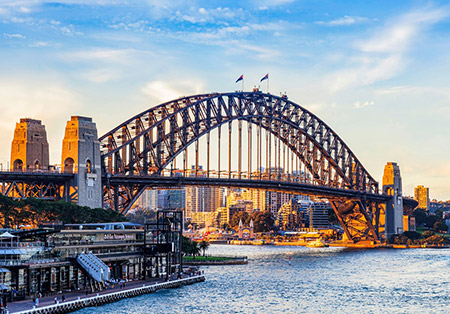Sydney


Sydney
It is also essential that you look into what is in demand in Australia to plan your job hunting strategy well. According to the Australian Government, Department of Employment, Skills, Small and Family Business’s Australia Jobs Report 2018, the top industries that are looking for potential employees are:
Though there will be a drop in employment in the manufacturing, agriculture and the electricity and resources sectors due to a slowing of the market, there will still be opportunities available over the next few years.
In several cases you will be assessed via an interview – a face-to-face one or online or even phone. Your Special Category Visa makes you eligible to live and work in Australia without having to apply for a visa, making the move an easy step.
Sydney covers a large area and you can choose to settle across any of the metro areas. In general it is seen that there is a preference for expensive localities closest to the city centre.
Sydney has four segments. The North has some of the wealthiest suburbs with expensive homes, often close to the beach. Independent homes give way to apartments and single family homes the closer you come to the centre. These are often areas where homes are bought rather than rented out. Though the Southern part of Sydney is far from the centre, it is well connected with rails and has a range of affordable housing closer to the beaches and national parks.
The East is the popular area for young professionals as well as singles and young couples. Accommodation is largely rental here, with shared homes being quite common. There are great schools here and commuting to the city centre is easy. West Sydney does have some good suburbs with a few lesser sought neighbourhoods as well. The accommodation here is generally cheaper than most other places. Inner West Sydney is where most university campuses are placed and therefore the student population in the region is high.
Renting or purchasing a home is a decision that is based on your duration of stay as well as your budget. Finding homes for either category can be done through local papers as well as specific websites and real estate agents.
When renting a home remember that most of them come unfurnished and don’t usually allow pets. Purchasing property involves buying both the land as well as the property, and this can be an expensive affair. Also keep in mind that despite Sydney being quite cold in the winters, some older homes are not well- heated or insulated. Summers also bring in a lot of creepy crawlies (not all of them friendly), so if this worries you, finding an apartment with sealed windows and screens would be an ideal option.
If you do buy or rent an unfurnished place, you can ship your possessions to Sydney – it may not be an expensive as you think. While the cheaper shipping options take a longer time, it gives you more time to find the perfect place to live.

Feel like a taste of Australia’s biggest city? Moving to Sydney is the dream for many Kiwis, who want a world of job opportunities, amazing weather and internationally famous beaches all at their doorstep.
Sydney is an expensive city to live in, though the quality of life is quite high. For a family of four, living in a rented accommodation with a moderate lifestyle, you will be looking at approximately AUD 33,600 annually for living expenses. Your rent will be an additional AUD 23,020. These costs will change based on the location you stay at, the schools you choose, the health insurance coverage you opt for and your fluctuating lifestyle expenses.
Sydney is recognized as one of the most diverse cities in the world. Census results show that 54.9% of the local city residents are born in other countries and around 36% have come from non-English speaking countries. Almost 41.3% speak a non-English language at home, with Mandarin being the most spoken at 11.3%. Almost 50% of the population is aged between 18 to 34 years, with 25 to 29 year olds making up 18%.
The city is also the centre of several migrant communities such as those from Lebanon, Fiji, Korea and Nepal. Residents from Ghana have a strong presence in Sydney. The 2016 census shows that NSW has an Indian population of around 150,000 and about 114,000 Kiwis.
Sydney enjoys an overall pleasant climate, with warm summers and not extremely cold winters. Summer is from December to February with average temperatures ranging between 18.6 – 25.8°C. There are humidity spikes that go up to 65%. In summers, water temperature at the beaches rises to 21.9 – 23.7°C, making for some great times. Autumn sets in around March and goes on till May with temperatures ranging between 14.6 – 22.2°C. Winters are from June to August where average temperatures are between 8.8 – 17°C. Sydney also gets most of its rainfall at this time. July is usually the coldest month. Spring is between September and November with daily temperatures hovering between 11 – 23°C.
Sydney offers a range of options for educational requirements. You have the option of public, faith-based, private, as well as international schools to choose from. There are quite a few prestigious universities, including the University of New South Wales and the University of Sydney for those looking to pursue their higher education. Pre-school is a common choice, with day-care centres offering pre-schooling classes of their own. Primary schools are usually co-educational. Single-sex high schools are another option in Sydney. Permanent residents and Kiwis can access the public education system for free.
Just like with the rest of Australia, the healthcare system in Sydney is funded through Medicare. This is a service that is available to all citizens and permanent visa holders including Kiwis. It is also the norm that expat permanent residents often prefer to have independent health insurance coverage in addition to Medicare, at least until they become permanent residents. It is important to look into what is covered with Medicare and opt for additional coverage based on the exclusions.
Sydney has a comprehensive public transport system that includes networks of trains, buses and ferries. These include light rails, airport linkages, sightseeing buses as well as taxis that provide last mile connectivity. All of them work in tandem.
Smartcards such as the Opal Card are freely available and can be loaded for use on trains, buses, ferries as well as light rails, going beyond city transport networks. The NSW’s Transport Info page will help you chart out routes and the best modes of transport to get from one point to another.
The train networks connect the four sectors of the city to each other. Services begin as early as 4AM and go on till midnight. The stations all have 24-hour ticket vending machines. The NSW TrainLink will take you to major cities as well as sight-seeing spots such as Newcastle, Wollongong and Blue Mountains.
Buses in Sydney operate 24-hours a day on a pre-paid route basis. The Airport Link functions from all City Circle stations going to the international and domestic terminals every 10 minutes. The line opens at 5AM and goes till midnight every day.
Transdev, the light rail operator has multiple services that you can choose from and several routes to choose from. They function on different timings for each sector and route and so it is best to check up before you head out. The Harbour ferries begin at Circular Quay and travel to tourist locations such as the Taronga Zoo as well as to suburbs like Balmain, Kirribilli and Neutral Bay.
You can hail taxis from the kerbside of a street or from any of the designated taxi stands all around the city centre. You can also book through private taxi service providers.
You can use your Kiwi licence in Australia for the first three months with no issues. After that, you need to apply for a NSW drivers licence. The process is pretty painless but you need to do it to avoid fines if you’re pulled over.
Thanks to its climate and terrain, Sydney offers some great options for outdoor activities, whether on sea or on land. Boating, as well as sailing and hiking are popular. Sydney is home to the famous annual Hobart Yacht Race in December. Sports like rugby, cricket, baseball, Aussie rules and netball are quite popular. There are numerous public pools that are well maintained and are a great option. Particularly during the summers you will find quite a few outdoor movie screenings taking place. October is the month of food fairs and January sees the Sydney Arts Festival.
The beach is of course a default leisure spot with Bondi beach being the most popular. There are also several activities to be found at the city’s recreational and learning centres. Long road trips to cities outside of Sydney are also a popular choice.
Sydney is a great choice to move to. For Kiwis, there is not much of a change from your NZ lifestyle but it’s a bigger city with lots of opportunities and a great lifestyle. If you like theme parks, beaches and mild weather then Sydney could be your perfect destination.

Ausmove understand and appreciate the trust you are placing in us to relocate your much-loved possessions to another country. We know you are relying on our experience and reputation. This is what drives us to ensure we either meet or exceed your expectations. Our commitment extends beyond our shores, to our Queensland service partners. We can be trusted to find the most cost-effective options, assist with documentation, and make sure there are no hidden costs or nasty surprises waiting for you upon arrival in Australia. At Ausmove we celebrate diversity and foster an environment where everyone feels valued. If you are only sending a few items, you will receive the same level of service and consideration as other customers with full 40-foot containers.